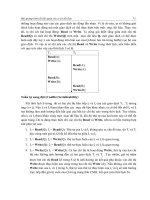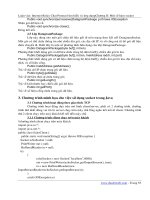Programming Linux Games phần 7 ppsx
Bạn đang xem bản rút gọn của tài liệu. Xem và tải ngay bản đầy đủ của tài liệu tại đây (245.82 KB, 43 trang )
GAME SCRIPTING UNDER LINUX 247
Let’s see exactly how this is done.
Code Listing 6–2 (tclshell.c)
/* A simple but functional Tcl shell. */
#include <stdio.h>
#include <stdlib.h>
#include <tcl.h>
int main()
{
Tcl_Interp *interp;
char input[16384];
/* Create an interpreter structure. */
interp = Tcl_CreateInterp();
if (interp == NULL) {
printf("Unable to create interpreter.\n");
return 1;
}
/* Add custom commands here. */
/* Loop indefinitely (we’ll break on end-of-file). */
for (;;) {
int result;
char *message;
/* Print a prompt and make it appear immediately. */
printf("> ");
fflush(stdout);
/* Read up to 16k of input. */
if (fgets(input, 16383, stdin) == NULL) {
printf("End of input.\n");
break;
}
/* Evaluate the input as a script. */
result = Tcl_Eval(interp, input);
248 CHAPTER 6
/* Print the return code and the result. */
switch (result) {
case TCL_OK:
message = " OK ";
break;
case TCL_ERROR:
message = "ERR ";
break;
case TCL_CONTINUE:
message = "CONT";
break;
default:
message = " ?? ";
break;
}
printf("[%s] %s\n", message, Tcl_GetStringResult(interp));
}
/* Delete the interpreter. */
Tcl_DeleteInterp(interp);
return 0;
}
This program implements a very simple command-line Tcl shell. It collects input
from standard input (up to 16K of it), evaluates it with Tcl Eval, and prints the
result, along with any errors that occurred.
To compile this Tcl shell, you’ll need the Tcl library and the floating-point math
library:
$ gcc -W -Wall -pedantic tclshell.c -o tclshell -ltcl -lm
Your Tcl library may be named differently; if it refuses to link with -ltcl, try
-ltcl8.2 or -ltcl8.3. Failing these, look for something starting with libtcl in
/usr/lib or /usr/local/lib and use that name. (This is the kind of situation in
which Autoconf would be handy; more on this in Chapter 10.)
GAME SCRIPTING UNDER LINUX 249
Go ahead and give this program a try. Feed it some of the scripts from earlier in
the chapter or anything else you can think of. Remember that this simple shell
can’t handle partial statements; for instance, you can’t enter proc foo { } { on
one line and expect to continue it on the next. You can exit with an end-of-file
character (Ctrl-D) or with the built-in exit command.
Structure Tcl Interp
Synopsis Encapsulates a Tcl interpreter’s stack, variables, and
script. Tcl Interp is a large structure, but most of it
is meant to be internal to Tcl.
Members result—Most recently set result, as a string. (You
may retrieve a Tcl interpreter’s most recent result as a
Tcl object with Tcl GetObjResult.)
freeProc—Function to call if Tcl DeleteInterp is
ever invoked on this interpreter. You only need to use
this if you’ve set the result pointer to memory that
you own and you’d like a chance to free it before the
pointer is lost.
errorLine—If Tcl Eval returns TCL ERROR, this will
contain the line number of the error. Read-only.
Function Tcl CreateInterp()
Synopsis Allocates a new Tcl Interp structure and prepares it
to receive a script.
Returns Pointer to a new Tcl Interp, or NULL on error.
Function Tcl DeleteInterp(interp)
Synopsis Shuts down and deletes a Tcl interpreter.
Parameters interp—Pointer to the Tcl Interp to delete.
250 CHAPTER 6
Function Tcl Eval(interp, script)
Synopsis Evaluates a string in the given interpreter.
Returns One of several codes on success (usually TCL OK), and
TCL ERROR on failure.
Parameters interp—Tcl interpreter to evaluate script in.
script—String containing a complete Tcl script to
evaluate.
Function Tcl EvalFile(interp, filename)
Synopsis Evaluates a script file in the given interpreter.
Returns One of several codes on success (usually TCL OK), and
TCL ERROR on failure.
Parameters interp—Tcl interpreter to evaluate the script file in.
filename—Filename of the script to execute.
Understanding Commands and Objects
Tcl represents data as objects (of type Tcl Obj). This abstract structure allows
Tcl to deal with strings, integers, and floating-point numbers without having to
convert between types more than necessary. Tcl Obj is an abstract datatype,
and you should avoid touching it directly. Tcl supplies functions for creating and
accessing Tcl Obj variables as strings, integers, and doubles. The library can
convert Tcl Obj objects between variable types whenever it needs to; for
instance, if you create a variable as an integer and then try to access it as a
string, Tcl will perform this conversion behind the scenes. There is no real limit
to the number of variables you can create, but you should probably think twice
about creating more than a few hundred (it’s rarely necessary and performance
could suffer).
GAME SCRIPTING UNDER LINUX 251
Tcl CreateObjCommand creates a new command and adds it to a given
interpreter.
3
It takes a pointer to a Tcl Interp, a command name, a pointer to
a handler function, an optional piece of “client data” (an integer), and a pointer
to a cleanup function. Whenever the new command is called from within Tcl, the
interpreter will give control to the handler function and await a result. It also
passes the client data for the particular command to the handler; this data serves
no defined purpose, so you can use it for just about anything. For instance, you
could implement several distinct commands in one handler function, and use the
client data to decide which body of code to execute. The cleanup function is
optional. Tcl calls it when it’s time to delete a command from the interpreter,
but it is useful in only a few cases. We’ll generally set this to NULL.
Function Tcl CreateObjCommand(interp, name, proc,
clientdata, deleteproc)
Synopsis Adds a new command to the given Tcl interpreter.
See Listing 6–3 for the exact usage of this function.
Returns Command handle of type Tcl Command.
Parameters interp—Interpreter to receive the new command.
name—Name of the new command, as a string.
proc—Command handler procedure. See Listing 6–3
for an example of a command handler.
clientdata—Data of type ClientData (integer) for
your own usage. Tcl will pass this integer value to
proc each time it is called. You can use this to
“multi-home” commands (serve several commands
with the same handler).
deleteproc—Function to call when this command is
deleted (or the interpreter containing this command is
3
There is also a Tcl CreateCommand function, but this interface is obsolete for performance
reasons. In fact, you’ll notice that a lot of Tcl library functions are obsolete. The entire
library was given a serious overhaul a while back, which improved performance drastically
but left a mound of obsolete interfaces behind. They still work, but it’s better to avoid them.
252 CHAPTER 6
deleted). This function should return void and accept
one argument of type ClientData (the same
clientdata listed above). If this command doesn’t
require any particular cleanup, just pass NULL.
Pretty easy, huh? Don’t worry about the details; they’ll become apparent when
we implement Penguin Warrior’s scripting engine. Let’s do it!
A Simple Scripting Engine
It’s time for some results. We know enough about Tcl and its library to create a
simple but practical scripting interface for our game. We’ll then be able to
implement the computer player’s brain as an easily modifiable script.
Source Files
We will add three files to Penguin Warrior in this chapter: scripting.c,
scripting.h, and pw.tcl. The first is the C source code that embeds
the Tcl library, the second is a header file that declares our scripting
interface, and the third is the Tcl script that our scripting engine will
execute automatically. In addition, we will link Penguin Warrior against
the libtcl.so shared library.
The basic job of the scripting engine is to provide an interface between the game
engine and a script. Ideally, the script will act just like any other player, from
the game engine’s perspective. It will observe its surroundings, formulate a plan,
provide the game engine with input for controlling a ship, and eventually destroy
its target. We’ll talk more about writing the Tcl side of this project in the next
section. For now we’ll concentrate on building the Tcl library interface.
Our script will need several pieces of information, as well as the ability to cause
changes in the game world. First, we’ll need to give it the positions of the two
players in the world, as well as their headings and velocities. This will give the
script enough information to figure out where the opponent ship is relative to
the human player. The script also needs a way to control the opponent ship’s
throttle, heading, and weapons. There are several possible ways to make this
control available to the script.
GAME SCRIPTING UNDER LINUX 253
We could define Tcl commands for getting this information and controlling the
opponent ship. Tcl commands are easy to create, they provide decent
performance, and we can have them return information in any format we desire.
However, handler functions can get a bit messy, especially if we want one handler
function to process more than one Tcl command. Instead, we’ll communicate
using global variables. Our scripting engine will define variables with the
information about each ship, and it will update these each time the script is
called. Our script will be able to make modifications to some of these variables
(its throttle and angle, for instance), and the scripting engine will give these
back to the main game engine at each frame. Tcl makes this simple with the
Tcl LinkVar command.
Function Tcl LinkVar(interp, name, addr, type)
Synopsis Links a Tcl variable to a C variable, so that any
accesses to the Tcl variable will result in accesses to
the C variable. This is a convenient way to share data
between scripts and C programs.
Returns TCL OK on success, TCL ERROR on failure.
Parameters interp—Tcl interpreter to perform the link in.
name—Name of the Tcl variable to create.
addr—Pointer to the C variable that name should
reference.
type—Data type of the C variable. Valid types are
TCL LINK INT, TCL LINK DOUBLE, TCL LINK BOOLEAN
(int), and TCL LINK STRING.
To demonstrate a custom Tcl command, we’ll create a command for controlling
the opponent ship’s weapons. It’ll be called fireComputerWeapons, and it will
have to respect the same firing limitations as the human player. This function
won’t actually do anything until we add weapons (in Chapter 9).
Thanks to the Tcl library, none of this is too hard to implement. Here’s our
scripting system (scripting.c) in its entirety:
254 CHAPTER 6
Code Listing 6–3 (scripting.c)
#include <stdio.h>
#include <stdlib.h>
#include <string.h>
#include <tcl.h>
#include "scripting.h"
/* Our interpreter. This will be initialized by InitScripting. */
static Tcl_Interp *interp = NULL;
/* Prototype for the "fireWeapon" command handler. */
static int HandleFireWeaponCmd(ClientData client_data,
Tcl_Interp * interp,
int objc, Tcl_Obj * CONST objv[]);
/* Ship data structures (from main.c). */
extern player_t player, opponent;
/* Sets up a Tcl interpreter for the game. Adds commands
to implement our scripting interface. */
void InitScripting(void)
{
/* First, create an interpreter and make sure it’s valid. */
interp = Tcl_CreateInterp();
if (interp == NULL) {
fprintf(stderr, "Unable to initialize Tcl.\n");
exit(1);
}
/* Add the "fireWeapon" command. */
if (Tcl_CreateObjCommand(interp, "fireWeapon",
HandleFireWeaponCmd, (ClientData) 0,
NULL) == NULL) {
fprintf(stderr, "Error creating Tcl command.\n");
exit(1);
}
/* Link the important parts of our player data structures
to global variables in Tcl. (Ignore the char * typecast;
Tcl will treat the data as the requested type, in this
GAME SCRIPTING UNDER LINUX 255
case double.) */
Tcl_LinkVar(interp, "player_x", (char *) &player.world_x,
TCL_LINK_DOUBLE);
Tcl_LinkVar(interp, "player_y", (char *) &player.world_y,
TCL_LINK_DOUBLE);
Tcl_LinkVar(interp, "player_angle", (char *) &player.angle,
TCL_LINK_DOUBLE);
Tcl_LinkVar(interp, "player_accel", (char *) &player.accel,
TCL_LINK_DOUBLE);
Tcl_LinkVar(interp, "computer_x", (char *) &opponent.world_x,
TCL_LINK_DOUBLE);
Tcl_LinkVar(interp, "computer_y", (char *) &opponent.world_y,
TCL_LINK_DOUBLE);
Tcl_LinkVar(interp, "computer_angle", (char *) &opponent.angle,
TCL_LINK_DOUBLE);
Tcl_LinkVar(interp, "computer_accel", (char *) &opponent.accel,
TCL_LINK_DOUBLE);
/* Make the constants in gamedefs.h available to the script.
The script should play by the game’s rules, just like the
human player.
Tcl_SetVar2Ex is part of the Tcl_SetVar family of functions,
which you can read about in the manpage. It simply sets a
variable to a new value given by a Tcl_Obj structure. */
Tcl_SetVar2Ex(interp, "world_width", NULL,
Tcl_NewIntObj(WORLD_WIDTH), 0);
Tcl_SetVar2Ex(interp, "world_height", NULL,
Tcl_NewIntObj(WORLD_HEIGHT), 0);
Tcl_SetVar2Ex(interp, "player_forward_thrust", NULL,
Tcl_NewIntObj(PLAYER_FORWARD_THRUST), 0);
Tcl_SetVar2Ex(interp, "player_reverse_thrust", NULL,
Tcl_NewIntObj(PLAYER_REVERSE_THRUST), 0);
}
/* Cleans up after our scripting system. */
void CleanupScripting(void)
{
if (interp != NULL) {
Tcl_DeleteInterp(interp);
}
}
256 CHAPTER 6
/* Executes a script in our customized interpreter. Returns 0
on success. Returns -1 and prints a message on standard error
on failure.
We’ll use this to preload the procedures in the script. The
interpreter’s state is maintained after Tcl_EvalFile. We will
NOT call Tcl_EvalFile after each frame - that would be
hideously slow. */
int LoadGameScript(char *filename)
{
int status;
status = Tcl_EvalFile(interp, filename);
if (status != TCL_OK) {
fprintf(stderr, "Error executing %s: %s\n", filename,
Tcl_GetStringResult(interp));
return -1;
}
return 0;
}
/* Handles "fireWeapon" commands from the Tcl script. */
static int HandleFireWeaponCmd(ClientData client_data,
Tcl_Interp * interp,
int objc, Tcl_Obj * CONST objv[])
{
/* Do nothing for now. We’ll add weapons to the game later on. */
fprintf(stderr, "Computer is firing weapon. Not implemented.\n");
/* Return nothing (but make sure it’s a valid nothing). */
Tcl_ResetResult(interp);
/* Succeed. On failure we would set a result with Tcl_SetResult
and return TCL_ERROR. */
return TCL_OK;
}
/* Runs the game script’s update function (named "playComputer").
Returns 0 on success, -1 on failure. */
int RunGameScript()
GAME SCRIPTING UNDER LINUX 257
{
int status;
/* Call the script’s update procedure. */
status = Tcl_Eval(interp, "playComputer");
if (status != TCL_OK) {
fprintf(stderr, "Error in script: %s\n",
Tcl_GetStringResult(interp));
return -1;
}
/* Enforce limits on the script. It can still "cheat" by turning
its ship more quickly than the player or by directly modifying
its position variables, but that’s not too much of a problem.
We can more or less trust the script (it’s part of the game). */
if (opponent.accel > PLAYER_FORWARD_THRUST)
opponent.accel = PLAYER_FORWARD_THRUST;
if (opponent.accel < PLAYER_REVERSE_THRUST)
opponent.accel = PLAYER_REVERSE_THRUST;
while (opponent.angle >= 360)
opponent.angle -= 360;
while (opponent.angle < 0)
opponent.angle += 360;
return 0;
}
In addition to this code, we’ll need to add some fairly obvious hooks into main.c
(to initialize the scripting engine and call RunGameScript at each frame) and
create a pw.tcl script. We’ll talk about the script shortly. Let’s break this code
down.
InitScripting sets up a fresh Tcl interpreter and adds our game’s interface to
the interpreter. At this point our interface consists of only one function (which is
empty for now) and a few variables. We take advantage of Tcl’s variable linking
feature, which causes a Tcl variable to track a C variable. Every access to a
linked variable within a Tcl script translates into an access to the corresponding
C variable.
The next function of interest is LoadGameScript. Our game uses this function to
load the script in pw.tcl at startup. Tcl EvalFile works just like Tcl Eval,
258 CHAPTER 6
except that it reads its input from a file instead of a string. If it returns anything
but TCL OK, LoadGameScript prints an error message and reports failure.
RunGameScript is the heart of our scripting engine. This function is responsible
for giving control to the script once each frame to let the enemy ship steer itself
and fire its weapons. To do this, RunGameScript calls Tcl Eval to invoke the
playComputer script command. If there are no errors, RunGameScript performs
some basic checks on the script’s actions and then returns. Tcl Eval takes care
of the rest.
Finally, the CleanupScripting function frees the Tcl interpreter. No surprises
here.
We now have a working scripting engine. If you want to see it run, you can find
this version of the Penguin Warrior code in the ph-ch6 subdirectory of the
source archive.
Now let’s talk about creating a decent game script. We won’t quite reach a Star
Trek level of artificial intelligence, but hopefully we can make life difficult for the
(human) player.
Designing a Game Script
Our game script is charged with one simple mission: to track down and blow up
the player. It has the ability to steer a ship, control its thrust, and activate its
weapons. It also has access to the player’s current position in the world. At a
glance, our script should look something like this:
1. Figure out where the player is with respect to our script’s ship, and find
the angle that will point us in that direction.
2. Decide whether a clockwise or counterclockwise turn would reach that
angle the fastest.
3. If the player is in front of us, fire our weapons.
4. Lather, rinse, repeat.
These steps shouldn’t be too difficult to implement in Tcl. Let’s give it a try.
GAME SCRIPTING UNDER LINUX 259
Code Listing 6–4 (pwscript-firsttry.tcl)
# Penguin Warrior game script (Tcl).
# A first attempt.
proc playComputer { } {
global computer_x computer_y computer_angle computer_accel
global player_x player_y player_angle player_accel
# Global constants. These are initially set by InitScripting().
global world_width world_height
global player_forward_thrust player_reverse_thrust
# Find our distance from the player.
set distance [getDistanceToPlayer]
# If we’re close enough to the player, fire away!
if {$distance < 200} {
fireWeapon
}
# Figure out the quickest way to aim at the player.
set target_angle [getAngleToPlayer]
set arc [expr {$target_angle - $computer_angle}]
if {$arc < 0} {
set arc [expr {$arc + 360}]
}
# Turn 15 degrees at a time, same as the player.
if {$arc < 180} {
set computer_angle [expr {$computer_angle + 15}]
} else {
set computer_angle [expr {$computer_angle - 15}]
}
# Apply a reasonable amount of thrust.
set computer_accel 5
# That’s it! Exit from Tcl_Eval and go back to the C-based engine.
}
260 CHAPTER 6
# Returns the distance (in pixels) between the player and the opponent.
# This is just the Pythagorean formula.
proc getDistanceToPlayer { } {
global computer_x computer_y player_x player_y
set xdiff [expr {$computer_x - $player_x}]
set ydiff [expr {$computer_y - $player_y}]
return [expr {sqrt($xdiff * $xdiff + $ydiff * $ydiff)}]
}
# Returns the angle (in degrees) to the player from
# the opponent. Uses basic trig (arctangent).
proc getAngleToPlayer { } {
global computer_x computer_y player_x player_y
set x [expr {$player_x - $computer_x}]
set y [expr {$player_y - $computer_y}]
set theta [expr {atan2(-$y,$x)}]
if {$theta < 0} {
set theta [expr {2*3.141592654 + $theta}]
}
return [expr {$theta * 180/3.141592654}]
}
Give this script a go. (It’s in the pw-chapter6 directory as
pwscript-firsttry.tcl; you’ll need to symlink or copy it to pw.tcl for the game
to find it.) As you can guess by the name, it’s not quite what we’re looking for.
Yes, the computer’s ship does follow the player around, and with weapons it
would probably win pretty quickly. The problem is that the script is too
good—it doesn’t give the player a fair chance. The computer’s ship is basically
impossible to avoid. Once it manages to get behind the player, it’s very difficult
to get rid of. This would make for a very boring game (aside from the fact that
the weapons don’t work yet).
So we need to make the computer a little bit worse at the game. A few things
come to mind. We could limit its speed or rate of turning, but that would be
cheesy (and probably very easy to notice). It would be better to give the
GAME SCRIPTING UNDER LINUX 261
Seek player, fire if close Seek random target
ATTACK state EVADE state
Reached random target
Too close to player
Figure 6–1: State diagram for Penguin Warrior’s improved script
computer’s AI a bit more depth, so that it would act more like a human and less
like a machine with a one-track mind. A human player makes a conscious effort
to avoid the enemy’s line of fire and periodically seizes an opportunity to attack.
Our script would be more interesting if it were to follow this behavior.
To accomplish this, we’ll use a simple state machine. The computer’s ship will
always be in either attack or evade mode, and it might switch between these two
states at any time based on its position in the world and the position of the
player’s ship. In attack mode it will steer in the direction of the player, firing its
weapons if it gets close enough, and in evade mode it will home in on a random
target (other than the player) somewhere in the game world. It will switch into
evade mode whenever it gets too close to the player, and it will switch back into
attack mode whenever it reaches a randomly chosen point in the world. From
the player’s point of view, the computer-controlled ship will seem to dive in for
an attack and then quickly run off. Properly tuned, this looks surprisingly
similar to what a human player would do.
Here’s the code to make it happen:
Code Listing 6–5 (pwscript-improved.tcl)
# Penguin Warrior game script (Tcl).
# This version of the script implements two states:
# attack and evade. In the attack state, the opponent
# homes in on the player and fires its weapons. After it
# gets within a certain proximity of the player, it switches
262 CHAPTER 6
# to the evade state, in which it aims at a random point in the
# world.
# The name of our current state, attack or evade.
set state attack
# Coordinates to aim towards. In the attack state these will
# be set to the player’s position. In the evade state these
# will be set to random values.
set target_x 0
set target_y 0
proc playComputer { } {
global computer_x computer_y computer_angle computer_accel
global player_x player_y player_angle player_accel
global target_x target_y state
# Global constants. These are initially set by InitScripting().
global world_width world_height
global player_forward_thrust player_reverse_thrust
if {[string equal $state attack]} {
#
# Code for the attack state
#
# In attack mode, our target is the player.
set target_x $player_x
set target_y $player_y
# If we’re too close to the player, switch to evade.
set distance [getDistanceToTarget]
if {$distance < 30} {
set state evade
# Set an invalid target so the evade state will
# come up with a new one.
set target_x -1
return
}
GAME SCRIPTING UNDER LINUX 263
# If we’re far away, speed up. If we’re close, lay off
#the throttle.
if {$distance > 100} {
set computer_accel $player_forward_thrust
} elseif {$distance > 50} {
set computer_accel [expr {$player_forward_thrust/3}]
} else {
set computer_accel 0
}
# If we’re close enough to the player, fire away!
if {$distance < 200} {
fireWeapon
}
} else {
#
# Code for the evade state
#
# Have we hit our target yet?
#(within a reasonable tolerance)
if {abs($target_x - $computer_x) < 10 &&
abs($target_y - $computer_y) < 10} {
puts "Going back into ATTACK mode."
set state attack
return
}
# Do we need to find a new target?
if {$target_x < 0} {
# Select a random point in the world
#as our target.
set target_x [expr {int(rand()*$world_width)}]
set target_y [expr {int(rand()*$world_height)}]
puts "Selected new EVADE target."
}
set computer_accel $player_forward_thrust
}
264 CHAPTER 6
#
# State-independent code
#
# Figure out the quickest way to aim at our destination.
set target_angle [getAngleToTarget]
set arc [expr {$target_angle - $computer_angle}]
if {$arc < 0} {
set arc [expr {$arc + 360}]
}
if {$arc < 180} {
set computer_angle [expr {$computer_angle + 3}]
} else {
set computer_angle [expr {$computer_angle - 3}]
}
}
# Returns the distance (in pixels) between the target
# coordinate and the opponent.
proc getDistanceToTarget { } {
global computer_x computer_y target_x target_y
set xdiff [expr {$computer_x - $target_x}]
set ydiff [expr {$computer_y - $target_y}]
return [expr {sqrt($xdiff * $xdiff + $ydiff * $ydiff)}]
}
# Returns the angle (in degrees) to the target coordinate from
# the opponent. Uses basic trig (arctangent).
proc getAngleToTarget { } {
global computer_x computer_y target_x target_y
set x [expr {$target_x - $computer_x}]
set y [expr {$target_y - $computer_y}]
set theta [expr {atan2(-$y,$x)}]
if {$theta < 0} {
set theta [expr {2*3.141592654 + $theta}]
}
GAME SCRIPTING UNDER LINUX 265
return [expr {$theta * 180/3.141592654}]
}
We use a global variable to keep track of the state we’re currently in, and we test
the current state with a simple conditional. It would be a simple matter to add
more states to make for a more realistic opponent. (This might make for an
interesting project.) Note that our script no longer causes the opponent to run
after the player, per se, but rather has it move toward a target coordinate. In
attack mode, the target coordinate is changed each time the script is called to
reflect the player’s current position, so it’s all the same.
Most games would employ much more complex state machines (also known as
automatons) to give life to computer-controlled characters; indeed, Penguin
Warrior’s state machine is very simple. It’s also quite effective, however. If you
haven’t done so already, give this new script a try (rename pw-improved.tcl to
pw.tcl), and observe the opponent’s behavior. Much better! Now if there were
some weapons, it would be a worthy fight. Don’t worry; we’ll add this when we
finish off Penguin Warrior in Chapter 9.
Applying Scripting to the Real World
Penguin Warrior is a bit of a pedagogical example. Sure, it’s a playable game (or
will be soon enough), but it’s not something you’d expect to find on the shelf at
a computer store or given a good review on a gaming site. But the ingredients
we’ve used to create Penguin Warrior are industrial grade, and this book would
be pointless if we couldn’t apply them in the “real world.” To that end, let’s look
at some of the problems involved in implementing a scripting system in larger
projects. Bear in mind that this discussion applies to any scripting language:
Tcl, Scheme, Perl, Python, librep, or anything else you can grab Freshmeat
4
.
4
266 CHAPTER 6
calls to multiple interpreters
to handle characters.
Game engine makes multiple
Tcl interpreter
Tcl interpreter
Tcl interpreter
calls to one interpreter to
to handle characters
Game engine makes multiple Script is passed some sort
of identifier to select which
character to update.
Game engine makes
one call to the scripting
engine in each frame.
Script iterates through
each character and
performs update.
Game engine (C) Tcl interpreter
Game engine (C) Tcl interpreter
Game engine (C)
Multiple calls to a single context
Multiple scripting contexts
One call to a single context
Figure 6–2: Several possible scripting models
Single Versus Multiple Contexts
Suppose that you are making a game similar to StarCraft (a real-time strategy
game with hundreds of computer-controlled opponents in the world
simultaneously), and that you want to implement the scripting with Tcl. You’ll
obviously want to call Tcl Eval on part of the script at least once each frame.
The question is, do you create a separate Tcl Interp for each character in the
game, or do you run all of them through the same interpreter? In the latter case,
do you invoke the interpreter once for each character or once for the entire
group? (For lack of a better term, we’ll call an interpreter with a loaded script a
context.)
In the case of something like StarCraft, it would probably be a bad idea to use a
separate interpreter for each character in the game; that would be a horrendous
waste of memory and script loading time, even though it might make the
scripting system a bit easier to organize. In cases with only a few characters,
though, it might be desirable to use multiple scripting contexts.
If you decide to use a single interpreter for the whole thing, you still need to
decide whether you’ll make a single call to it at each frame and let it sort out all
of the different characters (through a loop of some sort, probably) or call the
GAME SCRIPTING UNDER LINUX 267
script once for each game character. The former has the advantage of fewer calls
to the scripting library (which can be expensive, depending on the language),
and the latter has the advantage of potentially simpler scripting. It’s hard to
predict how well either scenario will perform; if you’re faced with this question,
you might want to write some timing code to measure the total amount of time
spent in the scripting engine per frame.
Can We Trust the Script?
Security really doesn’t matter for a single-player game; if a player wants to
cheat, so what? For that matter, you might as well publish a list of cheat codes.
But it is a huge problem in multiplayer games. You can pretty much count on a
few lamers trying to mess up the game for everyone else. If the game depends on
an interpreted (rather than compiled) script for its rules, there’s a problem.
Someone will figure out how to change the code, and without proper safeguards,
this can make the game unfair for the rest of the players.
This problem becomes even worse in open source software. Everyone has access
to all of the code, and anyone can change it to their liking. Unless the other
players have some way of telling when someone’s copy of the game has been
modified, there’s no hope of preventing cheaters from spoiling the fun, unless the
players trust one other from the start.
Penguin Warrior is wide open to script abuse. The script can essentially take
direct control of either ship, and no limits are imposed. If security were an issue,
we would have to add a limit-checking system to prevent the script from making
illegal moves. Even then, the source code to the game would be available for all
to see and modify. Multiplayer games can avoid this problem by having all
players connect to a trusted central server. We’ll touch on multiplayer security in
the next chapter.
Script Performance
Script interpreters are usually pretty well optimized, but unless scripts are
compiled, they are always separated from the processor by at least one layer of
code. The exact speed ratio of interpreted code to native code varies among
languages, but don’t be surprised if a script runs at about a tenth the speed of
268 CHAPTER 6
equivalent C code. (Again, it could be better or worse, depending on a lot of
factors; if you’re concerned, benchmark it.) To achieve decent performance,
you’ll need to take the properties of your chosen language into account. Tcl, for
instance, isn’t very fast at list processing (though this has gotten much better of
late), while Scheme excels at lists. It probably wouldn’t be a good idea to use
the “one interpreter, one call” model mentioned previously with Tcl, but this
model would be quite natural in Scheme. Also, don’t be fooled by the
“compilation” modes of most scripting systems; TclPro and MzScheme can both
“compile” programs, but this does little more than hide the source. The code is
still interpreted in the same way it normally would be, except for the initial
parsing stage. (However, TclPro’s .tbc or MzScheme’s .zo bytecode formats
might be useful if you want to hide the source to your scripts.)
Another performance issue has to do with memory management. Tcl uses
reference counting to know when it can safely reclaim unused variable memory,
while Scheme and most other Lisp-like languages use much more complicated
“garbage collection” techniques. Scheme has plenty of reasons to use garbage
collection, but it means that a Scheme program will typically use more memory
than it really needs at any given time. Garbage collection often takes place very
suddenly, and it can cause noticeable delays in your program. There are ways to
avoid this problem (such as running the scripting system in a separate thread or
scheduling garbage collection yourself at safe times), but you would do well to
become informed about these quirks before you try to use one of these libraries.
Who’s Writing the Script?
As a final thought, it’s important to note that the people who write game scripts
often aren’t programmers. Scripting is part of creating maps and characters, and
this task often falls to artists and game designers. These are smart people, no
doubt, but they might not be up to speed on programming. This is actually one
of the main reasons for using scripting languages in games: they allow
nonprogrammers to make minor changes to the way a game behaves without
actually messing with the main source code. Scripting languages are usually
much simpler than C and C++. But even with a well-designed scripting system,
some people might have trouble grokking the language or the interface. The only
real solution is to document your scripting interface well, pick an intuitive
language, and be prepared to teach it to your scripters. Almost anyone can pick
up something like Tcl without too much effort, so be patient.
GAME SCRIPTING UNDER LINUX 269
We’ve covered a lot in this chapter, but there’s a lot more to game scripting than
we’ve mentioned here. If game scripting systems interest you, point your browser
to Gamasutra
5
and search for articles on scripting. Gamasutra frequently
publishes retrospective accounts from game teams after the release of major
products, and one can glean a lot of insight from the experiences of these
professionals.
5
Chapter 7
Networked Gaming with Linux
It all started with id Software’s Doom. Once the number of computers with
modems (mainly for surfing the bulletin board (BBS) systems of the time) had
reached critical mass, it became feasible to build multiplayer games in which the
players weren’t sitting at the same monitor or even in the same room. There
were others, but Doom was the one that really got people thinking about
networked gaming.
Quite frankly, modem-to-modem Doom was a huge hassle. The two players had
to have exactly the same version of the game, the same map (.wad) files, and
compatible modems with correct parameters. It was difficult or impossible to
change game settings after the connection was established, so the players
generally had to agree on these over the phone ahead of time. If the connection
failed, as would frequently happen, it was hard to know whether the next phone
ring would be your friend calling to explain the problem or his computer trying
to redial. Nonetheless, the allure of playing against a real human halfway across
town was enough to make deathmatch Doom one of the most popular games of
the time and to usher in a new era of online gaming.
You’re in luck! Today you don’t have to mess with modem init strings or design
your own transport protocol to add multiplayer support to your games. Instead,
you can rely on the operating system’s support for TCP/IP (the Internet’s
workhorse protocol) and the user’s existing Internet connection. It’s no longer
necessary to play with interrupts, serial ports, or flaky lines (though admittedly









